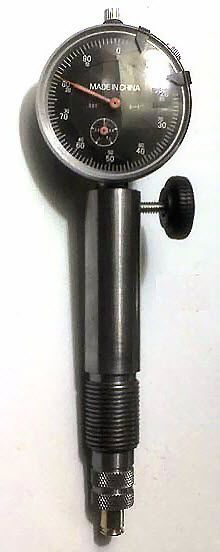It can be more than that. Below, I used the bullet base as a reference measuring a box of 150 grain SMK's. Note that the extreme spread of the base to nose is just over 1.5 times greater than from base to
the ogive contact location. The difference in these two measurements is the ogive contact point to nose dimension as referenced to your bullet comparator insert. Note that I used two different inserts. One is the aluminum insert sold with the Hornady comparator. The other, which finds the ogive lower down, is the stainless insert sold by Sinclair International.
The Sinclair insert is closer to an actual chamber throat dimension and is the better tool for that reason, IMHO. It fits either the Hornady or Sinclair caliper adapters, so you can buy it separately for whichever adapter you have. The difference in the caliper adapters is the Hornady is offset from the caliper jaw and anvil centerline for use with the Hornady Overall Length Gauge, while the Sinclair adapter is centered in a standard 6" caliper. But the inserts fit both and are interchangeable. An ideal bullet comparator insert is made using the same reamer that chambered your rifle. That will give you your actual ogival contact location. I have one for 223 I made this way.
You can see from the above mean values that the ogive contact location to bullet tip averages 0.5855" using the Hornady insert and 0.7295" using the Sinclair insert.
If you try to keep a tiny jump to the lands exact, you have two more problems. One is that, as Hatcher points out, chambering a round can size the case some, moving the bullet forward. IIRC he said he measured rapid fire pace bolt operation of a 1917 Enfield size a 30-06 down 0.006". So, gentle bolt work on a short bullet jump is important.
Another issue is that the commercial comparators measure a cartridge from the head to a contact location on the ogive rather than from the headspace seating surface to that contact point. In other words, not from the shoulder or the front edge of a rim or belt, which is what actually determines how far the bullet is inserted into the chamber when the firing pin shoves the cartridge forward.
If you want to know how far the ogive will be from the throat exactly, then that headspace seating surface to ogive throat contact location is the distance you want to know. I've seen cases from the same lot of Lake City 30-06 ammunition that was fired in different field grade Garand chambers come out of the same sizing die in the same setup on the same press with as much as 0.005" difference in length from head to shoulder, and the long ones having to be resized a second time. When all the cases are from the same chamber, but the case brand isn't very uniform, I've see up to about 0.002" difference even in the smaller 223 Rem case. Uniform cases with the same reloading and annealing history are more consistent.
For the above reason, I made myself a gauge that measures from the shoulder of a rimless bottleneck cartridge to the bullet ogive using my own chamber reamer to cut the shoulder and the bullet probe profiles. This was many years ago. Today you can buy the Redding Instant Indicator to make the same measurement using a sizing bushing (available in 0.001" increments) to contact the bullet ogive, plus make some other measurements. Checking loaded rounds with it, since my Redding Competition Seating Dies don't contact the bullet at the same point as the comparator and bullets in one box often aren't all off the same tooling, so the ogive profiles aren't an exact match, I still get about 0.002" of variation from round to round. This can be segregated by measurement and the micrometer seater adjusted to make them match, but I've never measured that mattering.
I also know that bullets don't necessarily shoot best close to the lands as many seem to think they do.
Berger found the same thing for their VLD bullets. The Late Dan Hackett, a benchrest shooter, had a 220 Swift that would not average better than ½ inch when seated 0.020" off the lands, but setting his Nosler BT's all the way back to 0.050" off the lands cut that group size by more than half. Every gun has its own preferences, and you just have to find it.


